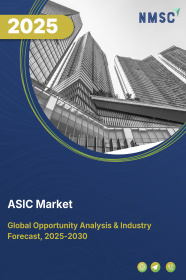
South Korea Smart Dust Market by Component (Sensors, Active Optical Transmission, Passive Optical Transmission, Optical Receiver, Analog I/O, Signal Processing, Control Circuitry, Power Source, and Others), by Manufacturing Process (3D Printing and Microfabrication), by Type (Biodegradable and Non-Biodegradable) and Others– Opportunity Analysis and Industry Forecast 2026-2030
Industry: Semiconductor & Electronics | Publish Date: 14-Feb-2025 | No of Pages: 127 | No. of Tables: 93 | No. of Figures: 58 | Format: PDF | Report Code : SE1925
US Tariff Impact on South Korea Smart Dust Market
Trump Tariffs Are Reshaping Global Business
Market Definition
The South Korea Smart Dust Market will value at USD 7.5 million in 2025 and is predicted to reach USD 22.2 million by 2030, at a CAGR of 20.6% from 2026 to 2030. The incorporation of modern advanced technologies emphasizes miniaturization and automation. The evolution of computing has been marked by increased connectivity, reduction in the size of computing devices, and enhanced communication with the world. The growing popularity of smaller computing devices such as mobile phones and handheld computers, alongside the advancement of micro sensors and micro transistors, has significantly accelerated the development of further nano computing devices.
Thus, increased interaction with the environment and the emergence of small computing elements offers enriched opportunities to reshape interactions among computers, humans, and the environment. These factors have led to the development of Smart Dust, which is composed of various microelectromechanical systems (MEMS) including sensors and other devices capable of detecting light, temperature, magnetism, vibration, or chemicals, among other parameters. Typical Smart Dust comprises nano-structured silicon sensors that can independently orient, sense, assemble, and report on the environment it is placed in.
Industrial Monitoring Capabilities of Smart Dust is Expected to Increase its Adoption in South Korea
The industrial monitoring capabilities of smart dust in the country are forecasted to drive its adoption to new heights. With its ability to furnish real-time data on various aspects of industrial operations, such as equipment performance, environmental conditions, and safety parameters, smart dust provides unparalleled insights for optimizing efficiency and productivity. By facilitating continuous monitoring and predictive maintenance, smart dust aids businesses in minimizing downtime, reducing operational costs, and improving overall performance.
As industries worldwide aim for increased automation, efficiency, and sustainability, the demand for smart dust solutions is anticipated to soar, leading to widespread adoption across diverse sectors from manufacturing and energy to transportation and logistics. This heightened adoption is set to revolutionize industrial processes and pave the way for a smarter, more interconnected future.
Integration of Smart Dust in the Medical Sector is Expected to Drive the South Korea Market in the Coming Years
The integration of smart dust into the medical realm is positioned to revolutionize healthcare practices in the country in the foreseeable future. With its miniature size and wireless connectivity, smart dust sensors can be inserted into the human body to monitor various vital signs, identify early signs of disease, and even administer targeted treatments. This advancement allows for real-time data collection, leading to more precise diagnoses and tailored medical interventions. Additionally, the continuous monitoring enabled by smart dust enhances preventative care and enables timely interventions, ultimately enhancing patient outcomes and reducing healthcare costs. Consequently, the adoption of smart dust in the medical sector is expected to drive significant growth in the smart dust market as healthcare providers increasingly recognize its potential to transform healthcare service delivery.
Privacy Concerns Associated with Smart Dust Hinders the South Korea Market Growth
Privacy concerns linked with smart dust present a significant obstacle to market growth in the country. While the technology offers unprecedented capabilities for data collection and analysis, the constant monitoring it enables raises apprehensions about individual privacy and data security. Users worry about the potential for unauthorized access to sensitive information collected by smart dust sensors, as well as the possibility of covert surveillance.
These concerns are further compounded by the sheer ubiquity of smart dust deployment, raising questions about consent and control over personal data. As a result, individuals, businesses, and regulatory bodies are hesitant to fully embrace smart dust technology, slowing its market expansion as stakeholders seek robust solutions to address these privacy challenges.
Introduction of Smart Dust in Space Research is Expected to Create Ample Opportunities in the South Korea Market
The implementation of smart dust in space exploration is positioned to unlock ample opportunities in the domain in the country. By utilizing its minute size, wireless connectivity, and advanced sensing capabilities, smart dust enables unparalleled data collection and analysis in space missions. These tiny sensors can be dispersed across vast cosmic landscapes to acquire valuable insights on celestial bodies, atmospheric conditions, and spacecraft performance.
Additionally, smart dust technology facilitates real-time monitoring and adaptive decision-making, enhancing the efficiency and success of space missions. As space agencies and private entities increasingly depend on data-centric approaches to explore the cosmos, the demand for smart dust solutions is predicted to surge, propelling market growth and innovation in the space research sector.
Competitive Landscape
Various market players operating in the South Korea smart dust market include HP, Cisco Systems Inc, Analog Devices, Lightricity Ltd, IBM, CubeWorks, SINTEF, Sonardyne International Ltd, General Electric, and Hitachi.
South Korea Smart Dust Market Key Segments
By Component
-
Sensors
-
Active Optical Transmission
-
Passive Optical Transmission
-
Optical Receiver
-
Analog I/O
-
Signal Processing
-
Control Circuitry
-
Power Source
-
Others
By Manufacturing Process
-
3D Printing
-
Microfabrication
By Type
-
Biodegradable
-
Non-Biodegradable
By Applications
-
Humidity Monitoring
-
Temperature Monitoring
-
Surveillance
-
Pressure & Stress Monitoring
-
Sound Monitoring
-
Others
By End User
-
Aerospace & Defense
-
Pharmaceutical & Lifesciences
-
Agriculture
-
Industrial
-
Government
-
Construction
-
Transportation & Logistics
-
Telecommunication
-
Others
REPORT SCOPE AND SEGMENTATION:
|
Parameters |
Details |
|
Market Size in 2025 |
USD 7.5 Million |
|
Revenue Forecast in 2030 |
USD 22.2 Million |
|
Growth Rate |
CAGR of 20.6% from 2026 to 2030 |
|
Analysis Period |
2025–2030 |
|
Base Year Considered |
2025 |
|
Forecast Period |
2026–2030 |
|
Market Size Estimation |
Million (USD) |
|
Growth Factors |
|
|
Companies Profiled |
10 |
|
Customization Scope |
Free customization (equivalent up to 80 analysts working hours) after purchase. Addition or alteration to country, regional & segment scope. |
|
Pricing and Purchase Options |
Avail customized purchase options to meet your exact research needs. |
KEY PLAYERS
-
HP
-
Cisco Systems Inc.
-
Analog Devices
-
Lightricity Ltd.
-
IBM
-
CubeWorks
-
SINTEF
-
Sonardyne International Ltd.
-
General Electric
-
Hitachi

















 Speak to Our Analyst
Speak to Our Analyst




















